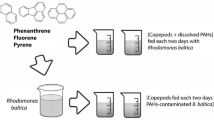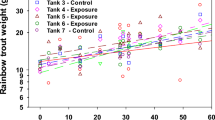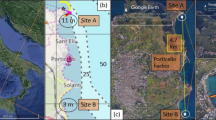Abstract
The uptake, elimination, and metabolism of14C-picric acid (2,4,6-trinitrophenol) and14C-picramic acid (2-amino-4,6-dinitrophenol) were determined for the American oyster (Crassostrea virginica). The oyster accumulated statistically significant amounts of picric and picramic acid above two exposure concentrations in a biphasic uptake pattern. The 42-day14C-accumulation factors (14C-AF) for American oysters continuously exposed to picric acid concentrations of 0.45 mg/L and 0.05 mg/L were 65.5 and 16.5, respectively. Oysters exposed to 0.24 mg/L and 0.02 mg/L picramic acid had 42-day14C-AFs of 49.3 and 86.8, respectively. Steady state bioconcentration factors could not be calculated (hence the use of the term14C-AF), because 1) it is not clear that an equilibrium was reached for either picric or picramic acid uptake during the 42 days of exposure, particularly for the high picric acid and low picramic acid exposure concentrations, and 2) some of the parent compounds were metabolized to other compounds.
No statistically significant elimination of picric acid was observed during the 14-day elimination study. Depuration of picramic acid was biphasic. Approximately 40% of the accumulated compound was eliminated by the second day of depuration during the initial phase for both the high and low concentrations of picramic acid, while no elimination occurred during the secondary phase. A small percentage of picric and picramic acid was metabolized by the oyster or its bacterial flora. There was no apparent difference between the concentration of the compounds per gram of tissue in the muscle, gill, mantle, or body mass.
Similar content being viewed by others
References
Adamson RH, Dixon RL, Francis FL (1965) Age, sex and species variation in azo and nitro reductase. Proc Nat Acad Sci (Wash) 54:1386
Anderson JW (1979) An assessment of knowledge concerning the fate and effects of petroleum hydrocarbons in the marine environment. In: Vernberg WB, Calabrese A, Thurberg FP, Vernberg FJ (eds) Marine pollution: functional responses. Academic Press, New York, pp 3–21
APHA (American Public Health Association, American Water Works Association and Water Pollution Control Federation) (1981) Standard methods for the examination of water and wastewater, 15 ed. American Public Health Association, Washington, DC, 1134 pp
Barka T, Anderson PJ (1965) Histochemistry theory, practice and bibliography. Harper and Row, New York, 660 pp
Berkowitz JB, Goyer MM, Harris JC, Lyman WJ, Nelken LH, Rosenblatt DH (1978) Literature review—problem definition studies on selected chemicals. Vol. III. Chemistry, toxicology and potential environmental effects of selected organic pollutants. Final Report. U.S. Army Medical Bioengineering Research and Development Laboratory, Fort Detrick, Frederick, MD, 278 pp
Bishop WW, Maki AW (1980) A critical comparison of two bioconcentration test methods. In: Eaton JG, Parrish PR, Hendricks AC (eds) Aquatic toxicology. STP 707, Amer Soc Testing Materials, Philadelphia, pp 61–77
Burrows D, Dacre JC (1975) Toxicity to aquatic organisms and chemistry of nine selected waterborne pollutants from munitions manufacture-a literature evaluation. Tech. Rep. AD A010660, U.S. Army Medical Bioengineering Research and Development Laboratory, Fort Derrick, Frederick, MD, 96 pp
Burton DT, Goodfellow WL Jr, Cooper KR (1983) Bioconcentration, elimination and metabolism of picric and picramic acid in freshwater fish and estuarine bivalves. Tech. Rep. AD A129-212, U.S. Army Toxic and Hazardous Materials Agency, Aberdeen Proving Ground, MD, 125 pp
Bysshe SE (1982) Bioconcentration factor in aquatic organisms. In: Lyman WJ, Reehl WF, Rosenblatt DH (eds) Handbook of chemical property estimation methods. Environmental behavior of organic compounds. McGraw-Hill, New York, pp 5-2–5-30
Call DJ, Brooke LT, Lu P-Y (1980) Uptake, elimination, and metabolism of three phenols by fathead minnows. Arch Environ Contain Toxicol 9:699–714
Chambers CW, Tobak HH, and Kabler PW (1963) Degradation of aromatic compounds by phenol-adapted bacteria, J Water Pollut Control Fed 35:1517–1528
Cunningham PA (1979) The use of bivalve molluscs in heavy metal pollution research. In: Vernberg WB, Calabrese A, Thurberg FP, Vernberg FJ (eds) Marine pollution: functional responses. Academic Press, New York, pp 183–221
Dedrick RL (1973) Animal scale-up. J Pharmacokinetics Biopharmaceutics 1:435–461
Dixon WJ, Brown WB (1979) Biomedical computer programs Pseries. Univ Calif Press, Berkeley, CA, 880 pp
Galstoff PS (1964) The American oysterCrassostrea virginica Gmelin. Fish Bull 64, US Dept. Interior, Washington, DC, 484 pp
Gillette JR (1977) The phenomenon of species variations; problems and opportunities. In: Parke DV, Smith RL (eds) Drug metabolism from microbe to man. Taylor and Francis Ltd., London, 147 pp
Goodfellow WL Jr, Burton DT, Graves WC, Hall LW Jr, Cooper KR (1983a) Acute toxicity of picric acid and picramic acid to rainbow trout,Salmo gairdneri, and American oyster,Crassostrea virginica. Water Resources Bull 19:641–648
Goodfellow WL Jr, Burton DT, Cooper KE (1983b) Effect of picric and picramic acids on growth of rainbow trout (Salmo gairdneri) and American oysters (Crassostrea virginica). Chemosphere 12:1259–1268
Gundersen K, and Jensen HL (1956) A soil bacterium decomposing organic nitro-compounds. Acta Agr Scandinava 6:100–114
Hamelink JL (1977) Current bioconcentration test methods and theory. In: Mayer FL, Hamelink JL (eds) Aquatic toxicology and hazard evaluation. STP 634, Amer Soc Testing Materials, Philadelphia, pp 149–161
Hancock WS, Battersby JE, Harding DRK (1975) The use of picric acid as a simple monitoring procedure for automated peptide synthesis. Anal Biochem 69:497–503
Hoffsommer JC, Glover DJ, Hazzard CY (1980) Quantitative analysis of polynitrophenols in water in the micro to nano-gram range by reversed-phase ion-pair liquid chromatography. J Chromatogr 195:435–440
Kenaga EE, Goring CAI (1980) Relationship between water solubility, soil sorption, octanol-water partioning, and concentration of chemicals in biota. In: Eaton JG, Parrish PR, Hendricks AC (eds) Aquatic toxicology. STP 707, Amer Soc Testing Materials, Philadelphia, pp 78–115
Kirby BA (1951) The formation of β-ketoadipic acid by bacterial fission of aromatic rings. Biochem J 49:671–674
Levy G, Gibaldi M (1975) Pharmacokinetics. In: Gillette JR, Mitchell JR (eds) Handbook of experimental pharmacology: concepts in biochemical pharmacology, Vol. 28 (Part 3), Springer-Verlag, New York, pp 1–34
Matsuguma HJ (1967) Nitrophenols. In: Standen A (ed) Kirk-Othmer Encyclopedia of chemical technology, Vol. 13, 2 ed. Interscience Publishers, New York, 888 pp
Mayer FL (1976) Residue dynamics of di-2-ethylhexyl phthalate in fathead minnows (Pimephales promelas). J Fish Res Board Can 33:2610–2613
Melancon MJ Jr, Lech JJ (1978) Distribution and elimination of naphthalene and 2-methylnaphthalene in rainbow trout during short- and long-term exposures. Arch Environ Contain Toxicol 7:207–220
— (1979) Uptake, biotransformation, disposition, and elimination of 2-methylnapthalene and napthalene in several fish species. In: Marking LL, Kimerle RA (eds) Aquatic toxicology. STP 667, Amer Soc Testing Materials, Philadelphia, pp 5–22
Nagal R, Urich K (1980) Kinetic studies on the elimination of different substituted phenols by goldfish (Carassius auratus). Bull Environ Contam Toxicol 24:374–378
Neff JM, Cox BA, Dixit D, Anderson JW (1976) Accumulation and release of petroleum-derived aromatic hydrocarbons by four species of marine animals. Mar Biol 38:279–289
Spacie A, Hamelink JL (1982) Alternative models for describing the bioconcentration of organics in fishes. Environ Toxicol Chem 1:309–320
Sprague JB (1969) Measurement of pollutant toxicity to fish. I. Bioassay methods for acute toxicity. Water Res 3:793–821
Stegeman JJ, Teal JM (1973) Accumulation, release and retention of petroleum hydrocarbons by the oysterCrassostrea virginica. Mar Biol 22:37–44
Vanderhorst JR, Gibson CI, Moore LT, Wilkinson P (1977) Continuous-flow apparatus for use in petroleum bioassay. Bull Environ Contam Toxicol 17:577–584
Wilkerson R (1951) Treatment and disposal of waste waters containing picric acid and dinitrophenol. Ind Chem 27:9–12, 59–64
Author information
Authors and Affiliations
Rights and permissions
About this article
Cite this article
Burton, D.T., Cooper, K.R., Goodfellow, W.L. et al. Uptake, elimination, and metabolism of14C-picric acid and14C-picramic acid in the American oyster (Crassostrea virginica). Arch. Environ. Contam. Toxicol. 13, 653–663 (1984). https://doi.org/10.1007/BF01055928
Received:
Revised:
Issue Date:
DOI: https://doi.org/10.1007/BF01055928




